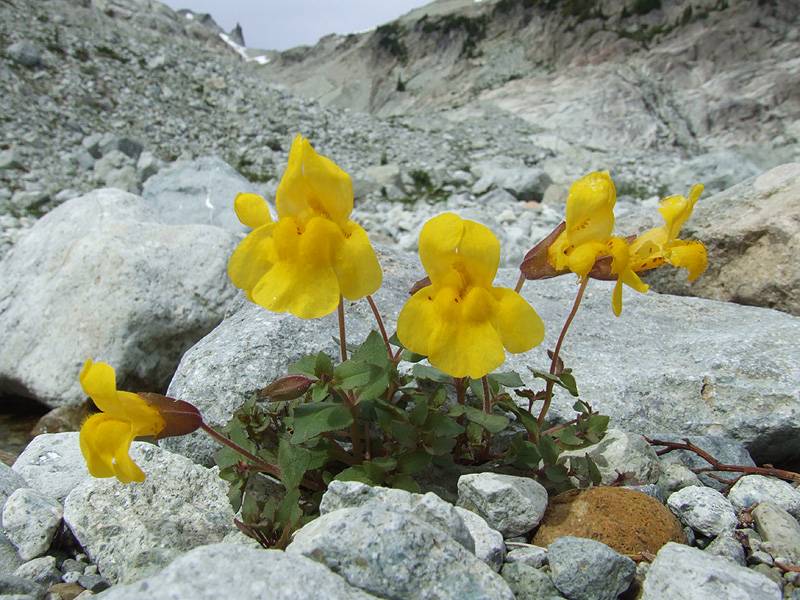Erythranthe tilingii
Erythranthe arvensis
field monkey-flower
Leaves opposite, mostly sessile, the blade under 2.5 cm. long, elliptic to ovate, slightly reduced upward, with a few irregular teeth, sub-palmately veined.
Leaves basal and cauline, or basal leaves may not persist, mid-stem or higher leaves often largest and becoming smaller distally; petiolate, petioles 3-20, distally sessile;
blade ovate to orbicular to oblong, middle and distal cauline leaves may be orbicular to nearly reniform, generally 10-35 mm long and 6 to 26 broad, 3-5 palmately-arranged veins, earlobe-like appendages near base, base rounded to truncate to slightly cordate, margins distinctly toothed to nearly entire, larger plants show lower leaves lacerate lobed to pinnatifid margin bases, apex rounded, surfaces glabrous except bracts densely villous beneath and occasionally above, long eglandular hairs flattened and sometimes transparent.
Flowers few, solitary in the leaf axils, on long pedicels;
calyx 5-toothed, irregular, the upper tooth much the largest, the 2 lower ones tending to fold upward;
corolla large for the size of the plant, 2-4 cm. long, strongly bilabiate, with flaring throat, yellow with maroon dots or splotches on the pubescent lower lip;
stamens 4.
Axillary flowers generally 3-8, emerging from distal-most nodes; fruiting pedicels eglandular and smooth, longer than subtending leaves, typically 5-40 mm;
calyx sometimes with red dots, ovate to campanulate, inflated, compressed along sagittal plane, 9-14 mm, slightly hirtellous, throat sometimes closed or open, lobes curving upward weakly, top lobe not significantly longer than lower lobe, not distinctly curved;
corollas yellow, commonly with red spots, weak bilateral symmetry or near radial symmetry, slightly bilabiate or almost regular;
tube-throat cylindric to funnel-shaped, 8-12 mm, protruding 1-2 mm past calyx margin;
limb expanded 5-10 mm;
styles glabrous;
anthers not protruding, glabrous.
Capsule.
Capsules 6-7 mm, included, stalked.
Erythranthe tilingii
Erythranthe arvensis
- Local floras:
BC,
CA,
OR
- Local Web sites:
CalFlora,
CalPhotos,
Flora NW,
PNW Herbaria
WildflowerSearch
iNaturalist (observations)
- LBJ Wildflower Center
- SEINet
- Plants of the World Online
- Encyclopedia of Life
- Wikipedia
- Google Image Search
- Local floras:
BC,
CA,
OR,
WA
- Local Web sites:
CalFlora,
CalPhotos,
Flora NW,
PNW Herbaria
WildflowerSearch
iNaturalist (observations)
- LBJ Wildflower Center
- SEINet
- Plants of the World Online
- Encyclopedia of Life
- Wikipedia
- Google Image Search



